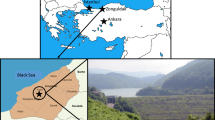Abstract
This study provides a predictive analysis of the potential disaster trajectory and extent of a tailings dam in Guangdong Province using GDEM-GAVA technology. Tailings dam failures are complex events characterised by high non-linearity and unpredictability. The research results show that the tailings debris flow followed an inverted V-shaped pattern. The tailings sand travelled approximately 800 m down the valley, with the furthest edge reaching 1387 m and the widest cross-valley spread at 90 m. The average deposition thickness was approximately 6 m and the peak velocity of the debris during erosion reached approximately 35 m per second. In particular, the debris flow engulfed and eroded significant parts of the processing plant, including the main plant area, the washing and screening workshop and the thickener basin. It also affected the storage area, covering approximately 10,000 square m. These findings provide an important scientific basis for early warning and risk assessment of potential tailings dam failures.










Similar content being viewed by others
Data Availability
Data will be provided on request.
References
Cai Z, Liu E, Chen N, Feng J, Hu G, Su Y (2022) Numerical analysis of the initiation and sliding process of the Yigong landslide using a continuous–discontinuous method. Environmental Earth Sciences 81(5):150
Carluccio GD, Pinyol Puigmartí NM, Perdices Cos P, Hurlimann Ziegler M (2019) Numerical modelling of Val d’Arán landslide with Material Point Method. Paper presented at the PARTICLES VI: proceedings of the VI international conference on particle-based methods: fundamentals and applications
Chen H-X, Li J, Feng S-J, Gao H-Y, Zhang D-M (2019) Simulation of interactions between debris flow and check dams on three-dimensional terrain. Eng Geol 251:48–62
Han Z, Su B, Li Y, Wang W, Wang W, Huang J, Chen G (2019) Numerical simulation of debris-flow behavior based on the SPH method incorporating the Herschel–Bulkley–Papanastasiou rheology model. Eng Geol 255:26–36
Hou H-L, Zhang G-P, Xin C, Zhao Y-Q (2020) Numerical simulation and process optimization of internal thread cold extrusion process. Materials 13(18):3960
Jia L, Wang J, Gao S, Fang L, Wang D (2023) Landslide risk evaluation method of open-pit mine based on numerical simulation of large deformation of landslide
La R, Han L, Bai P, Zhang Z (2022) demand forecast of geological disaster rescue equipment based on scenario-task. Geotech Geol Eng 40:1–24
Li S, Yuan L, Yang H, An H, Wang G (2020) Tailings dam safety monitoring and early warning based on spatial evolution process of mud-sand flow. Saf Sci 124:104579
Llano-Serna MA, Muniz-de Farias M, Martínez-Carvajal HE (2015) Numerical modelling of Alto Verde landslide using the material point method. Dyna 82(194):150–159
Luo C, Xu K, Zhao Y (2017) A TVD discretization method for shallow water equations: numerical simulations of tailing dam break. Int J Model, Simul, Sci Comput 8(03):1850001
Nguyen HT, Do TA, Cosson B (2019) Numerical simulation of submerged flow bridge scour under dam-break flow using multi-phase SPH method. Math Biosci Eng 16(5):5395–5418
Qu H, Dong W, Wang D, Zhang Z, Zhang W (2023) Slope response characteristics under the coupled action of rainfall and earthquake: a case study with numerical modelling. Geotech Geol Eng 41(4):2501–2515
Savage SB, Hutter K (1989) The motion of a finite mass of granular material down a rough incline. J Fluid Mech 199:177–215
Wang X, Li J (2017) A new solver for granular avalanche simulation: indoor experiment verification and field scale case study. Sci China Phys, Mech Astron 60:1–11
Wang J, Zheng H, Tian Z (2015) Numerical simulation with a TVD–FVM method for circular cylinder wake control by a fairing. J Fluids Struct 57:15–31
Wang X, Zhang Z, Li J (2019) Triaxial behavior of granular material under complex loading path by a new numerical true triaxial engine. Adv Powder Technol 30(4):700–706
Wang G, Tian S, Hu B, Chen J, Kong X (2021) Regional hazard degree evaluation and prediction for disaster induced by discharged tailings flow from dam failure. Geotech Geol Eng 39:2051–2063
Wang X, Yang S, Yu W, Yang X, Liu Q (2022) Runout and deflection of granular flow past an array of obstacles on a slope. Eur J Mech-B/fluids 94:37–49
Yang Y, Li J (2020) SPH-FE-based numerical simulation on dynamic characteristics of structure under water waves. J Marine Sci Eng 8(9):630
Yin J, Sun J-W, Jiao Z-F (2015) A TVD-WAF-based hybrid finite volume and finite difference scheme for nonlinearly dispersive wave equations. Water Sci Eng 8(3):239–247
Yu D, Tang L, Chen C (2020) Three-dimensional numerical simulation of mud flow from a tailing dam failure across complex terrain. Nat Hazard 20(3):727–741
Yu D, Tang L, Ye F, Chen C (2021) A virtual geographic environment for dynamic simulation and analysis of tailings dam failure. Int J Digit Earth 14(9):1194–1212
Zhang Y, Mang HA (2020) Global cracking elements: a novel tool for Galerkin-based approaches simulating quasi-brittle fracture. Int J Numer Meth Eng 121(11):2462–2480
Zhang Y, Zhuang X (2018) Cracking elements: a self-propagating strong discontinuity embedded approach for quasi-brittle fracture. Finite Elem Anal Des 144:84–100
Zhang Y, Zhuang X (2019) Cracking elements method for dynamic brittle fracture. Theoret Appl Fract Mech 102:1–9
Zhang Y, Zhuang X, Lackner R (2018) Stability analysis of shotcrete supported crown of NATM tunnels with discontinuity layout optimization. Int J Numer Anal Meth Geomech 42(11):1199–1216
Zhang Y, Huang J, Yuan Y, Mang HA (2021) Cracking elements method with a dissipation-based arc-length approach. Finite Elem Anal Des 195:103573
Funding
This study was financially supported by the National Key Research and Development Program of China (2023YFC3007203).
Author information
Authors and Affiliations
Corresponding author
Ethics declarations
Conflict of interest
The authors declare that there are no competing interests.
Additional information
Publisher's Note
Springer Nature remains neutral with regard to jurisdictional claims in published maps and institutional affiliations.
Rights and permissions
Springer Nature or its licensor (e.g. a society or other partner) holds exclusive rights to this article under a publishing agreement with the author(s) or other rightsholder(s); author self-archiving of the accepted manuscript version of this article is solely governed by the terms of such publishing agreement and applicable law.
About this article
Cite this article
Shuai, X., Liu, X., Wan, J. et al. Numerical Analysis of Tailings Dam Break Based on GDEM-GAVA. Geotech Geol Eng 42, 2833–2843 (2024). https://doi.org/10.1007/s10706-023-02708-x
Received:
Accepted:
Published:
Issue Date:
DOI: https://doi.org/10.1007/s10706-023-02708-x




